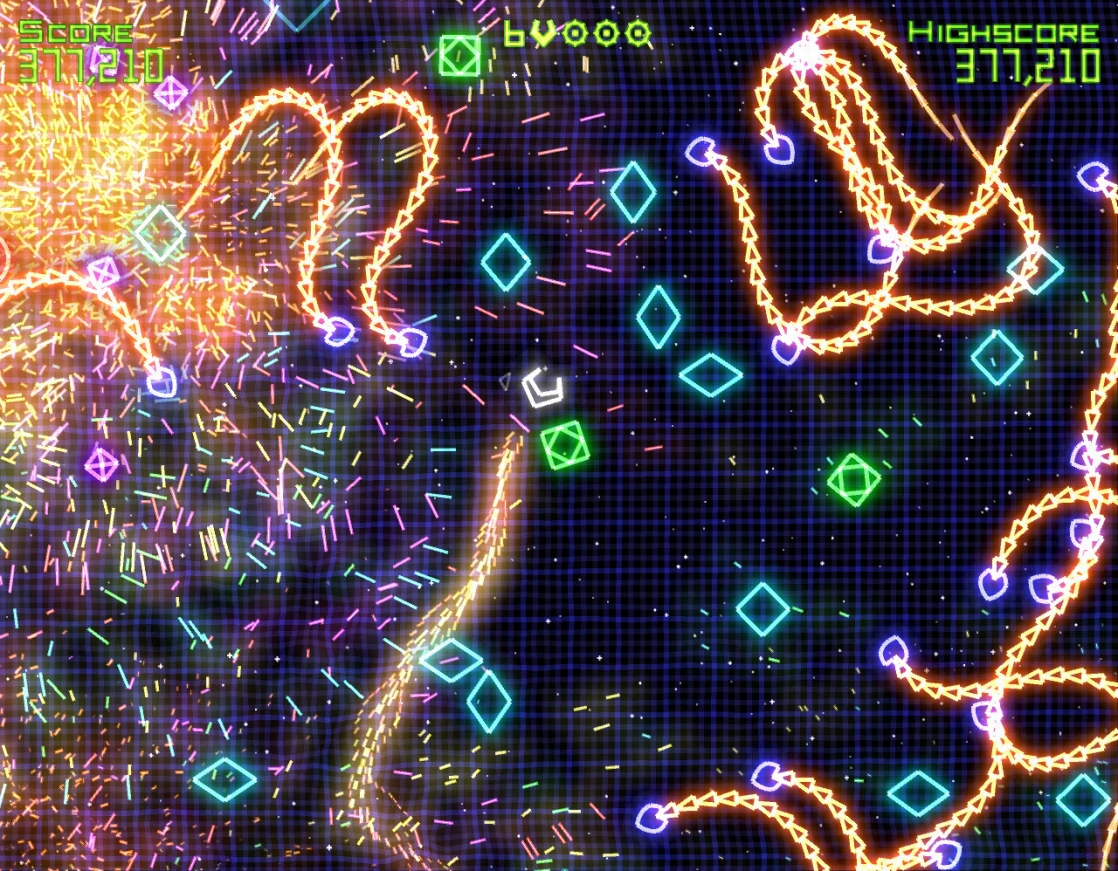Why I love Geometry Wars

The first Geometry Wars kick-started the XBLA revolution, becoming the first must-have title for the platform. What started as a mini-game in Project Gotham Racing grew into a wonderful, deep and compelling franchise.
I’ve poured hours into all three games in the series, and I’ve outlined below the reasons why I think it does so well in retaining my attention, and why more games should borrow design elements from GW .
Twin-stick simplicity
The only button on the controller you need to play Geometry Wars is the right shoulder trigger. In fact, you don’t even need it – you can play without triggering bombs at all.
The simplicity of the control scheme – move your ship with one stick, fire with the other – works so well because it strikes that perfect balance between being able to pick up and grasp instantly, and taking a long, long time to truly master. Achieving these two things is so difficult in game design, so few games manage it but those that do tend to produce legacies much greater than most.
Old-school competition
What Geometry Wars 2 in particular does so well is re-kindle that primal, high-score competitiveness that I find has become either watered down or lost altogether in games recently. GW2 makes it clear that it wants you to compete with your friends – each of the six game modes’ menus show a leaderboard, shoving your ranking in your face whenever you play. Awareness of how you compare to your peers is deliberately unavoidable.
The niggling annoyance created by being number 1 in just 5 of the 6 modes amongst my friends strikes a competitive chord deep within me, an urge that compels me to keep returning until I clinch the top spot. Once you finally manage to beat that score, the knowledge that the next time you turn on the console you might discover you’ve been usurped is a thrill found too rarely in modern gaming. Rivalries have been re-born with random Xbox Live friends added from back in the Halo 2 days, with cheeky emoticon messages sent whenever a score is beaten. It’s a real asset and such a simple feature that serves to extend the longevity of the game, it’s a wonder more games don’t put more emphasis on their leaderboards.
One more go…
Another notch in the GW belt is the bitesize nature of each session, and more importantly the ease and speed of retrying. Although in GW3 the length of the game depends on the game mode, of which there are many, a typical game doesn’t take longer than a few minutes. Every game in the series makes it almost too easy to retry – pressing ‘X’ just after you die in the third game lets you retry even before the session is technically over. Retrying is mindlessly simple.
The speed and ease of having another go is paramount in GW’s success, as burdening the player with even a few seconds of loading would be enough to lose the player’s interest. Other games recognise the importance of this too. Floaty platformer N+ allows you to retry midgame with a designated suicide button, a really clever addition saving the player from having to pause the game and scroll down to ‘retry’. It’s easy to not notice the effect when it’s done well, but when a game doesn’t respect the UX in this way it really shows. Burnout Revenge always sticks with me as an example of a game getting it wrong; an otherwise excellent experience is segmented horribly by a clunky retry system – having to wait for an animation to complete to show the summary of your race, followed by carefully navigating a menu to find the Retry button, only to be greeted with a loading screen when you press it gets frustrating very quickly.
Achievements
The final thing I’d like to touch on that GW gets very right that many other games get wrong is the achievements. All three games have a near-perfect curve of difficulty and variety in their achievement selection. Whilst I know they can be divisive, I love achievements and have strong views on what makes a good achievement and what does not, and GW is a great example of it done right.
Some of the first game’s achievements add a crucial goal to the games scoring – achieving 1 million points without dying is the final and hardest of the lot, and it’s elusiveness and outrageous challenge gives the player reason to continue playing. The infamous ‘Pacifism’ achievement is a great example of how achievements can force a player to play a game differently – demanding the player doesn’t fire their weapon for the first minute. Pacifism proved so popular it actually became a distinct game mode in GW2 and 3.
The achievements add another layer of replayability to the game, encouraging to the player to reach for goals outside of the leaderboard and playing for playing’s sake.
All of these elements combine to make the GW series an excellent example of how considered game design and UX can enhance the longevity of a title. I’d recommend these games to anyone.
Currently it looks like WordPress is the top blogging platform available
right now. (from what I’ve read) Is that what you are using on your blog?